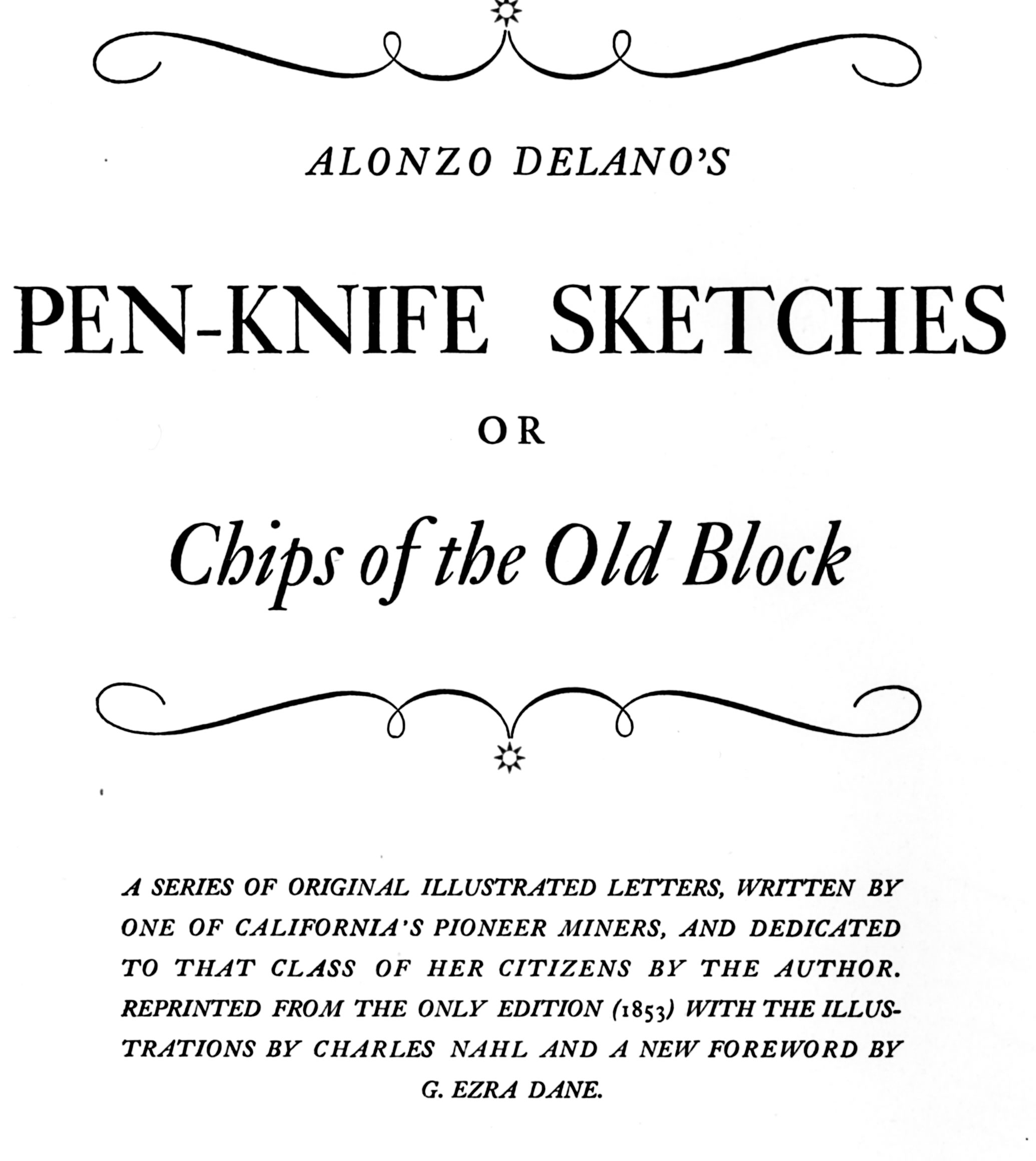Pen Knife Sketches or Chips of the Old Block
Old Block, Alonzo Delano 1853 79 pages
Most historians, if they were completely honest, would say they would like a time machine. That it’s supposed to be impossible leaves it off most Christmas lists. Imagine being able to travel back in time and experience first hand what you’ve only been able to read about – with the proviso that you could come back. Where would you go first?
The 1853 book Pen Knife Sketches of Chips of the Old Block by Alonzo Delano (Old Block) is the wish almost come true. It is a door into 19th Century California in twenty sketches or vignettes of California life. The “Pen Knife” part of the title refers to Old Block’s conversations with his pen knife which he uses to whittle the nib of his pens and also as a metaphor for whittling stories.
 In “The Greenhorn” the “ardent adventurer, just arrived by the way of the isthmus” with lumps of gold as large as pumpkins dancing in his imagination. He gets advice, gets accoutered for the diggings, and heads to the mines. He forgot a water bottle, the pack gets heavy and then heavier with travel, and the way gets steeper. At the diggings all the claims have been taken. He continues on and after “three or four weeks… his clothes worn out and hanging in rags upon him, his head unshaven and unshorn, with a heavy heart he turns his face once more towards the valley, wondering what ever induced him to leave the comforts of home, to seek gold in the mountains of California.” It’s a marvelous introduction to the stories that follow and a wonderful description of most gold seekers’ fates.
In “The Greenhorn” the “ardent adventurer, just arrived by the way of the isthmus” with lumps of gold as large as pumpkins dancing in his imagination. He gets advice, gets accoutered for the diggings, and heads to the mines. He forgot a water bottle, the pack gets heavy and then heavier with travel, and the way gets steeper. At the diggings all the claims have been taken. He continues on and after “three or four weeks… his clothes worn out and hanging in rags upon him, his head unshaven and unshorn, with a heavy heart he turns his face once more towards the valley, wondering what ever induced him to leave the comforts of home, to seek gold in the mountains of California.” It’s a marvelous introduction to the stories that follow and a wonderful description of most gold seekers’ fates.
The stories that follow are about miners’ lives, the traders who mine the miners, the express man who brings the mail to the camps, the gambler, a tour of San Francisco in six vignettes, some editorial content, some stories, the Isthmus of Panama crossing, and a description of Grass Valley. About the Express Man, Delano paints a picture, “Without him, the miner would be shut out from the world, and next to the trader, who furnishes the means of sustaining life, the Express man is of the most importance...” little else is thought of when news comes that the Express Man is on the way. “The Express Man has arrived! Every pick and shovel is dropped, every pan is laid aside, every rocker is dropped with its half=washed dirt, every claim is deserted and they crowed around the store, with eager enquiries…” With joy letters are seized and the miners care not how much they paid for the letters.” That’s for those who received letters. Others, not so luck go “sullenly back to work, unfitted by disappointment for social intercourse the rest of the day.”
 Charles Nahl, an artist friend of Delano’s provided the illustrations for the book and those are as good as the prose.The illustration to the left here is Nathl's depiction of San Francisco in 1852.
Charles Nahl, an artist friend of Delano’s provided the illustrations for the book and those are as good as the prose.The illustration to the left here is Nathl's depiction of San Francisco in 1852.
The time machine is working well with the descriptions of San Francisco,
“A city is before you. A confused mass of building of all descriptions, from the humble shed to a four story palace, from the cloth tents on the hillsides to the iron castles over the water: a motely throng of animate life, the din of active business… the rattling of carts, the passing of carriages… Pass through Kearney Street… what a sea of heads, what a moving mass of human beings meets the view!...It is like the waving of a field of corn in the breeze, a crowded mass of flesh and blood… Rows, fights, and robberies are the order of the day… and to see sin and depravity in its most glaring colors… Here, on the corner of Dupont, is the Polka; but we can’t get in there. It is crammed to overflowing; its tables are surrounded by a throng, who watch the turning of a card with anxious eyes; its bar is freely dispensing the bane of man in a variety of forms…” It’s a vivid description and one can imagine the activity.
The description of Grass Valley is also vivid and evocative of the early development of California, “…rich quartz veins were brought to light, crushing mills were built at an enormous expense, and through obstacles almost insurmountable roads were opened, good houses erected, and in a few short months the hissing sound of steam, the clack of the saw mill, the rattling of the daily mail coaches, the sumptuous tables of the hotels, the placards of lawyers and doctors, the signs of merchants and tradesmen, and what seems even strange now, a church arose in the wilderness…”
With Old Block’s descriptions you can set the stage for any story you’d want to tell.

